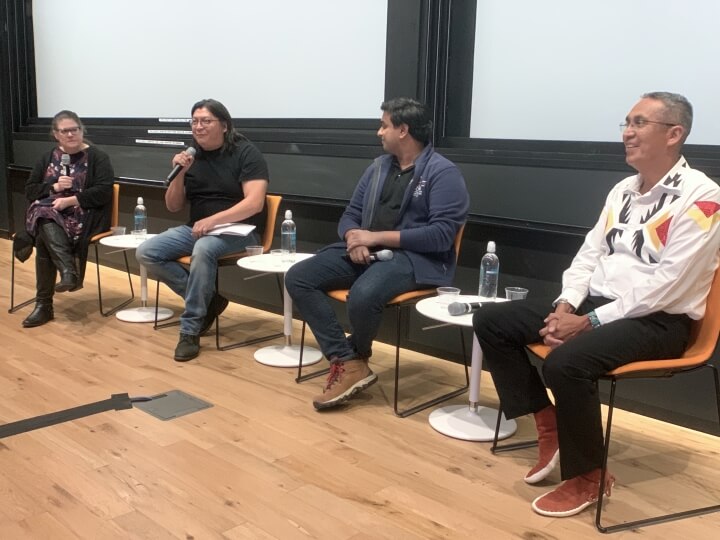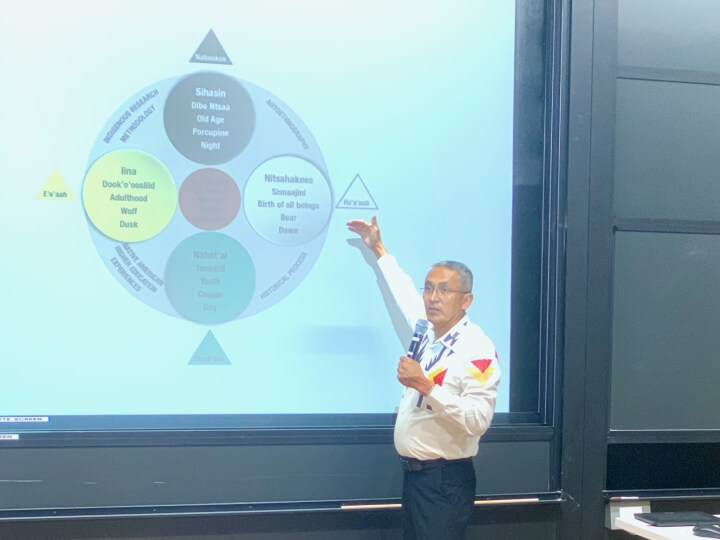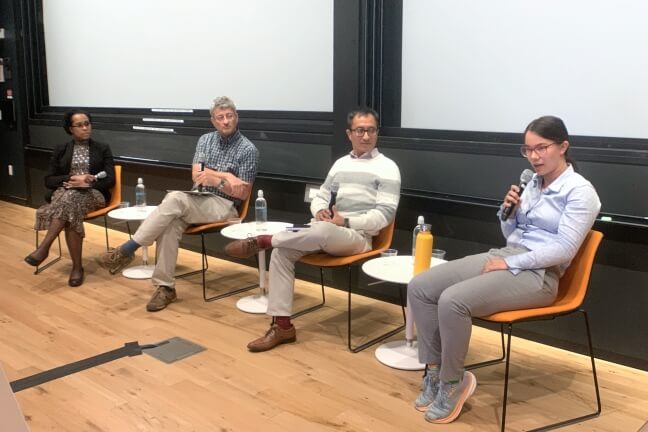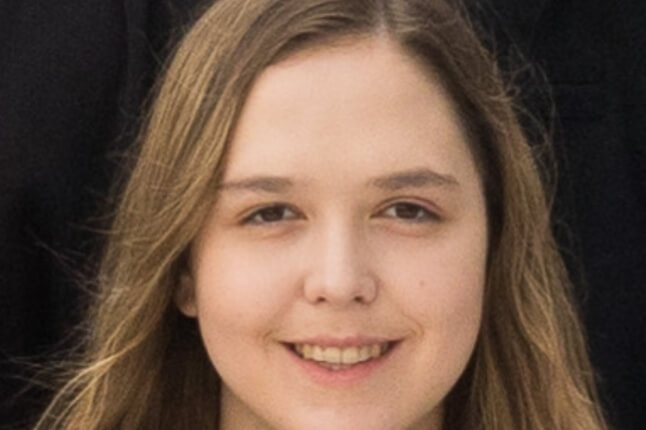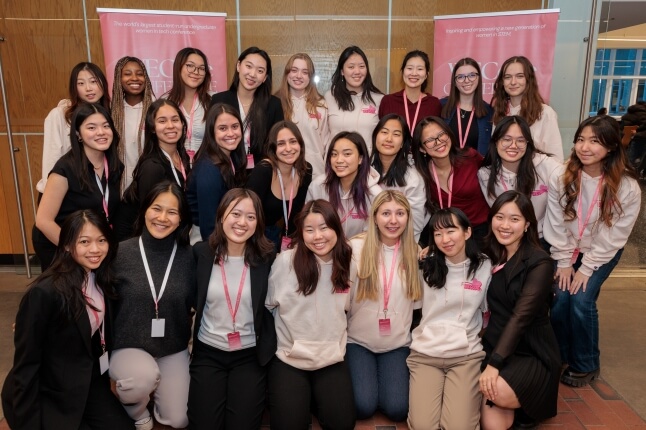News
SEAS Ph.D. student and Navajo Technical University (NTU) graduate Robinson Tom speaks at a panel with Ph.D. student Rohan Thakur, Franklin Sage, NTU Graduate Assistant Professor of Dine' Studies, and Kathryn Hollar, SEAS Director of Community Engagement and Diversity Outreach (Matt Goisman/SEAS)
How did members of the Navajo (Diné) Nation historically develop plant-based teas to aid in digestion or treat infection?
It took research, experimentation and replication of results to determine which plants and preparations provided benefits. Once a clear solution emerged, that information was distributed throughout the community and passed on from one generation to the next — not unlike the publication of research results.
“Way before formal education came onto our shores here, we had our own system of educating our youth, passing on our knowledge and passing on our culture,” said Dr. Franklin Sage, Graduate Assistant Professor of Dine' Studies at Navajo Technical University (NTU). “They were doing science, but they didn’t know it was called science. They didn’t know they were doing engineering – they were just doing it because it became part of their daily routine. All this philosophy and spirituality is woven into our daily lives.”
Sage was the keynote speaker and a panelist at “Beyond Western Approaches: Recognizing Indigenous Traditions in Engineering,” a recent symposium at the Harvard John A. Paulson School of Engineering and Applied Sciences (SEAS). Organized by the Office of Diversity, Inclusion, and Belonging, the event featured a series of panels focused on SEAS academic programming and initiatives that explore how Indigenous communities contribute to creating knowledge in engineering and applied sciences.
“One of the big messages from our government and elders is to go to school, get an education, climb that ladder, then come back and do good stuff,” said Robinson Tom, a third-year Ph.D. student in bioengineering at SEAS and NTU graduate. “One of the strongest things about engineering is that it can produce laboratories that can bring native scientists, doctors and engineers back to the reservation to actually give back to the people.”
Tom and Sage were two of three panelists for “Advancing Indigenous Engagement in Engineering Through Partnership: The Harvard-Navajo Technical University PREM Collaboration.” Led by Kathryn Hollar, SEAS Director of Community Engagement and Diversity Outreach, the concluding panel of the event explored the National Science Foundation (NSF)-funded Partnership in Research and Education in Materials (PREM) between NTU and the NSF Materials Research Science and Engineering Center at Harvard. The partnership includes the Research Experience of Undergraduates summer program, a post-baccalaureate program to help undergraduates transition to graduate school, and K-12 Teacher Engagement program.
“You can have a really profound impact just by telling someone they could be a scientist or engineer and encouraging them to do it,” said panelist Rohan Thakur, a G7 Ph.D. in the Weitz lab and one of Tom’s mentors. “This kind of partnership is really profound. We can mentor the folks from NTU who come here. When they go back, they’re already committed to helping their community, so it’s a much larger shockwave. It’s a huge return on investment for the engineering community to mentor students like this.”
Dr. Franklin Sage, Navajo Technical University Graduate Assistant Professor of Dine' Studies, presents his dissertation at "Beyond Western Approaches: Recognizing Indigenous Traditions in Engineering" at the Science and Engineering Complex (Matt Goisman/SEAS)
Tom first came to SEAS as an REU student, then returned for the post-baccalaureate program before joining the lab of David Weitz, Mallinckrodt Professor of Physics and Applied Physics.
“I thought it was cool to do research that would have such a strong impact on my community, which forced me to really look at the science we’re doing and try to translate that to everyday people on the reservation,” Tom said. “Because of the history between natives and the U.S. government, we have a huge distrust, and sadly that can include scientific research. This project made me learn how to communicate science to elderly people in a way that doesn’t feel like it’s bringing up some historical trauma.”
Sage opened the event with a discussion of his dissertation for his Ph.D. in Educational Foundations and Research at the University of North Dakota. As part of his research, he created a visual model based on the four cardinal directions on the map, which in the Navajo tradition can also represent their Four Sacred Mountains, the movement of the sun across the day, and the stages of life from birth to death, among other symbols. Sage overlaid this compass onto the stages of a dissertation or scientific experiment, from the beginning formulation of an idea to final dissemination of the results.
“To me, my dissertation is basic Navajo knowledge about the philosophy of education,” he said. “Today, now we’re discovering again that our ancestors knew about these things. For modern Navajo, we’re relearning these things and rediscovering ourselves as native people.”
Understanding the needs of the community is critical to engage native peoples, and that idea was central to the symposium’s other two panels. “Engaging Indigenous Communities: Exploring Gold Mining's Environmental Impact through the Harvard-UTEC Fieldwork Program” featured Joost Vlassak, Abbott and James Lawrence Professor of Materials Engineering, who discussed his annual Winter Session trip to Peru to explore the environmental effects of illegal gold mining. He was joined by Carlos Rios, professor at Universidad de Ingeniería y Tecnología in Peru and co-organizer of the trip, and Sophie-An Kingsbury Lee, a third-year environmental science and engineering student at SEAS who went on the trip last winter.
“A lot of things can be solved if you just pay attention to the other side of the table,” Rios said. “If you just listen and take time to change your perspective, it helps. You have to be careful. You have to be respectful. You have to be patient, and never promise anything you will not deliver.”
SEAS Assistant Dean for Diversity, Inclusion, and Belonging Paula Booke, left, leads a panel with Joost Vlassak, Abbott and James Lawrence Professor of Materials Engineering, Carlos Rios, professor at Universidad de Ingeniería y Tecnología in Peru, and Sophie-An Kingsbury Lee, A.B. '26 (Matt Goisman/SEAS)
SEAS postdoc Francisco Marmolejo-Cossío, left, leads a panel with Indigenous Mexican researchers Leydi Rojas Martínez, Edna Marlene Martínez Hernández and Rosa Adriana Rivas Castillo (Matt Goisman/SEAS)
The third panel, “Culturally Grounded Research: Indigenous Students’ Perspectives on Engineering Solutions for Their Communities,” was led by Francisco Marmolejo-Cossío, a postdoc in the EconCS Group at SEAS. Marmolejo-Cossío started the Summer of Science in 2022, pairing female Indigenous students with interdisciplinary researchers to find scientific and engineering solutions to challenges in their community. Conducting the panel in Spanish and translated using software, Marmolejo-Cossío led three Indigenous Mexican students in discussions of their research, which included the social determinants of populational health such as migration, physical and mental healthcare access and nutrition and food security; and familial domestic violence in Indigenous communities.
“Indigenous communities possess a vision of the world that is profoundly interconnected, where the human being's balance with nature and with spiritual aspects is fundamental for life, and to be in harmony with that,” said Edna Marlene Martínez. “Native wisdom also reminds us that these challenges cannot be resolved in isolation. They require more than one focus, an integral focus, where culture and territory and spirituality are taken into account. And we as researchers feel it is our task to learn from that, to collaborate and to acknowledge that we are not only doing research to generate knowledge, but it is also an alternative to find possible solutions to the problems that face our communities.”
Topics: Academics, Diversity / Inclusion, Environmental Science & Engineering
Cutting-edge science delivered direct to your inbox.
Join the Harvard SEAS mailing list.
Press Contact
Matt Goisman | mgoisman@g.harvard.edu
